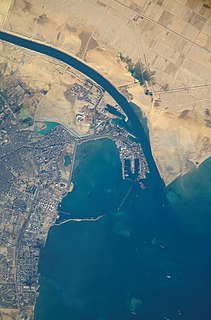
The Suez Canal is an artificial sea-level waterway in Egypt, connecting the Mediterranean Sea to the Red Sea through the Isthmus of Suez and dividing Africa and Asia. The canal is part of the Silk Road that connects Europe with Asia.

Suez is a seaport city in north-eastern Egypt, located on the north coast of the Gulf of Suez, near the southern terminus of the Suez Canal, having the same boundaries as Suez Governorate. It has three harbours, Adabiya, Ain Sokhna and Port Tawfiq, and extensive port facilities. Together they form a metropolitan area, located mostly in Africa with a small portion in Asia.

The Great Bitter Lake is a large saltwater lake in Egypt that is part of the Suez Canal. Before the canal was built in 1869, the Great Bitter Lake was a dry salt valley or basin. References are made to the Great Bitter Lake in the ancient Pyramid Texts.

The Lessepsian migration is the migration of marine species across the Suez Canal, usually from the Red Sea to the Mediterranean Sea, and more rarely in the opposite direction. When the canal was completed in 1869, fish, crustaceans, mollusks, and other marine animals and plants were exposed to an artificial passage between the two naturally separate bodies of water, and cross-contamination was made possible between formerly isolated ecosystems. The phenomenon is still occurring today. It is named after Ferdinand de Lesseps, the French diplomat in charge of the canal's construction.

The yellowtail barracuda is one of the smaller species of barracuda of the family Sphyraenidae, which can be found in Indo-West Pacific oceans. It has also invaded the Mediterranean through the Suez Canal from the Red Sea, making it one of the Lessepsian migrants.

Ismaily Sporting Club is an Egyptian professional football club, established on 20 March 1921 as El Nahda Sporting Club, based in Ismaïlia, Egypt. The club is best known for its football team. Also it's considered as an Egyptian National Club, where they helped the famous local tour of duty to play for the benefit of the homeland against the occupying armies. The club's nickname The Brazilians, is a reference to their uniforms, which echo those of the Brazil national team, and similar style of play.

The rock goby is a small coastal goby of eastern Atlantic waters, from Scotland to Senegal. It is also reported from the Mediterranean and Black Seas, and is an anti-Lessepsian migrant in the Gulf of Eilat and Red Sea. There are unconfirmed records from the area around Pointe Noire in Congo-Brazzaville.

Lithophaga lithophaga, also known as date shell or date mussel, is a species of Bivalvia belonging to the family Mytilidae.

Ismailia Canal or the Al-Ismāʿīliyyah Canal, formerly known as the Sweet Water Canal or the Fresh Water Canal, is a canal which was dug by thousands of Egyptian fellahin to facilitate the construction of the Suez Canal. The canal travels east-west across Ismailia Governorate.
The Société d'études du Canal de Suez was a society set up in 1846 by the Saint-Simonist Prosper Enfantin in Paris to study the Isthmus of Suez and the possibility of a Suez Canal.

Coryphellina rubrolineata is a species of sea slug, an aeolid nudibranch, a marine heterobranch mollusc in the family Flabellinidae.
The Suez Canal Corridor Area Project is a megaproject in Egypt that was launched on 5 August 2014 by president Abdel Fattah el-Sisi and completed in 2015. The project's aim was to increase the role of the Suez Canal region in international trading and to develop the three canal cities: Suez, Ismailia, and Port Said.
The Unified command of the area east of the canal is an Egyptian military formation that was created to combat the terrorism and insurgency in the Sinai. It is one of the five major military regions of the Egyptian Army. It groups the Second Field Army and the Third Field Army. A presidential Decree from Abdel Fattah al-Sisi appointed the command's first commander, Lieutenant General Osama Askar. The command was created to improve cooperation and unity of command and coordination between the Second and Third armies.

Modiolus barbatus, the bearded horse mussel, is a species of "horse mussel", a marine bivalve mollusc in the family Mytilidae, the mussels.

Brachidontes pharaonis is a species of mussel from the family Mytilidae. It is native to the Indian Ocean and the Red Sea, and has colonised the Mediterranean Sea where it is regarded as an invasive species.

Sphyraena chrysotaenia, the yellowstripe barracuda, is a species of predatory, ray finned fish from the family Sphyraenidae which is found in the Indo-West Pacific region. It has entered the Mediterranean Sea from the Red Sea through the Suez Canal as a Lessepesian migrant and is now an important species in the fisheries of the eastern Mediterranean.
Arcuatula perfragilis is a bivalve mollusc of the mussel family, Mytilidae, which has an Indo-Pacific distribution including the Red Sea. It has invaded the eastern Mediterranean from the Red Sea by way of the Suez Canal, a process known as Lessepsian migration.

Diodora rueppellii, common name the Rüppell's keyhole limpet, is a species of sea snail, a marine gastropod mollusc in the family Fissurellidae, the keyhole limpets.

Acanthochitona crinita is a species of marine chiton in the family Acanthochitonidae. It is found on rocky coasts in the northeastern Atlantic Ocean, the North Sea and the Mediterranean Sea.















